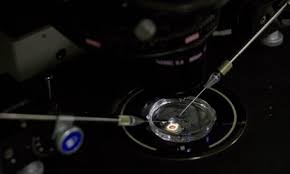Doctors could use Crispr tool to inject benign virus into foetus’s brain to ‘switch on’ key genes
Scientists are developing a radical form of gene therapy that could cure a devastating medical disorder by mending mutations in the brains of foetuses in the womb.
The treatment, which has never been attempted before, would involve doctors injecting the feotus’s brain with a harmless virus that infects the neurons and delivers a suite of molecules that correct the genetic faults.
Tests suggest that the therapy will be most effective around the second trimester, when their brains are in the early stages of development.
“We believe that this could provide a treatment, if not a cure, depending on when it’s injected,” said Mark Zylka, a a neurobiologist at the University of North Carolina.
The therapy is aimed at a rare brain disorder known as Angelman syndrome, which affects one in 15,000 births. Children with the condition have small brains and often experience seizures and problems with walking and sleeping. They can live their whole lives without speaking a word.
Zylka said children with Angelman syndrome can have such severe sleeping difficulties that parents can feel they must lock them in their rooms at night to prevent them from getting up and having accidents around the house.
Healthy people tend to have two copies of every gene in the genetic code, one inherited from their mother and the other from their father. But both copies are not always switched on. For normal brain development, the mother’s copy of a gene called UBE3A is switched on, while the father’s copy is silenced.
In Angelman syndrome, the mother’s copy of UBE3A is either missing or mutated, meaning there is no UBE3A active at all. Zylka’s therapy uses a version of a powerful gene editing tool known as Crispr-Cas9 to switch the father’s copy back on.
Studies in mice show that when the gene therapy is given in the womb, it activates UBE3A in key parts of the brain. Speaking at an American Association for the Advancement of Science meeting in Washington DC, Zylka said the therapy switched the gene on in the cortex, which is important for cognition, the hippocampus, which is crucial for learning and memory, and the cerebellum, which controls movement.

Follow-up work showed that it worked in human brain cells grown in a dish, too. “It really does raise the possibility that this gene therapy might be usable in humans,” Zylka said.
No one has ever developed a gene therapy that is injected directly into the brains of foetuses. But Zylka believes that if future work goes well, his therapy could be an important first that paves the way for treating other, more common disorders, such as certain forms of autism. “For many of these neurodevelopmental disorders, where the brain has been developing inappropriately because of a gene mutation, the best time to intervene is probably going to be early, very early,” he said.
Angelman syndrome can be detected as early as 10 weeks after conception with a test that picks up DNA from the foetus in the mother’s blood. But there are no treatments available for women who are told their baby has the disorder. “People are getting this diagnosis, and there’s nothing to be done, they have to make pretty difficult decisions at that point,” Zylka said. “This may give them another option.”
Source: The Guardian

































Leave a Comment
You must be logged in to post a comment.